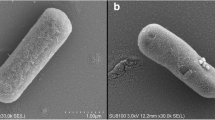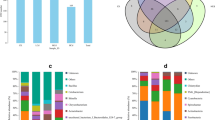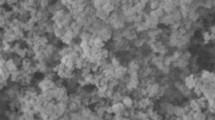Abstract
The heavy metal cadmium (Cd) is a hazardous pollutant that exerts various toxic effects on aquatic animals. The biomagnifying effects of this non-essential element in the food chain also pose threats to human health. In this study, the protective effect of a dietary probiotic supplementation, Lactobacillus plantarum CCFM8610, on the intestinal microbiota and physiological conditions of Nile tilapia (Oreochromis niloticus) exposed to waterborne Cd was evaluated. Two hundred fish were divided into four groups, i.e., control, probiotic-only, Cd-only and Cd-plus-probiotic. The fish were exposed to waterborne Cd at a level of 1 mg L−1 for 4 weeks and the probiotic was administered twice daily at 108 CFU g−1 in the fish diet. Waterborne Cd exposure caused a profound decline in the gut microbial diversity and marked alterations in the composition of the microbiota. Dietary supplementation with L. plantarum CCFM8610 reversed the changes in the intestinal microbiota composition in the Cd-exposed fish and reduced the abundance of Flavobacterium and Pseudomonas. Compared with the Cd-only group, the probiotic treatment significantly promoted growth performance and prevented the death of the Cd-exposed fish. L. plantarum CCFM8610 supplementation also decreased Cd accumulation and alleviated oxidative stress in the tissues, and reversed the alterations in hemato-biochemical parameters in the blood of fish. The results suggest that L. plantarum CCFM8610 can be considered a safe dietary supplement for the prevention of Cd-exposure-induced problems in aquaculture and food safety.




Similar content being viewed by others
References
Almeida J, Novelli E, Silva MDP, Júnior RA (2001) Environmental cadmium exposure and metabolic responses of the Nile tilapia, Oreochromis niloticus. Environ Pollut 114:169–175
Almeida J, Diniz Y, Marques S, Faine L, Ribas B, Burneiko R, Novelli E (2002) The use of the oxidative stress responses as biomarkers in Nile tilapia (Oreochromis niloticus) exposed to in vivo cadmium contamination. Environ Int 27:673–679
Amato KR et al (2013) Habitat degradation impacts black howler monkey (Alouatta pigra) gastrointestinal microbiomes. ISME J 7:1344–1353
ATSDR (Agency For Toxic Substances And Disease Registry of United States) (2015) Summary data for 2015 priority list of hazardous substances. http://www.atsdr.cdc.gov/spl/resources/atsdr_2015_spl_detailed_data_table.pdf. Accessed 10 Sep 2016
Bisanz JE, Enos MK, Mwanga JR, Changalucha J, Burton JP, Gloor GB, Reid G (2014) Randomized open-label pilot study of the influence of probiotics and the gut microbiome on toxic metal levels in Tanzanian pregnant women and school children. MBio 5:e01580
Boswell CD, Hewitt CJ, Macaskie LE (1998) An application of bacterial flow cytometry: evaluation of the toxic effects of four heavy metals on Acinetobacter sp. with potential for bioremediation of contaminated wastewaters. Biotechnol Lett 20:857–863
Chahid A, Hilali M, Benlhachimi A, Bouzid T (2014) Contents of cadmium, mercury and lead in fish from the Atlantic sea (Morocco) determined by atomic absorption spectrometry. Food Chem 147:357–360
Copat C, Arena G, Fiore M, Ledda C, Fallico R, Sciacca S, Ferrante M (2013) Heavy metals concentrations in fish and shellfish from eastern Mediterranean Sea: consumption advisories. Food Chem Toxicol 53:33–37
Costa GN, Marcelino-Guimarães FC, Vilas-Bôas GT, Matsuo T, Miglioranza LHS (2014) Potential fate of ingested Lactobacillus plantarum and its occurrence in human feces. Appl Environ Microbiol 80:1013–1019
Davis A, Maney D, Maerz J (2008) The use of leukocyte profiles to measure stress in vertebrates: a review for ecologists. Funct Ecol 22:760–772
Franklin NM, Glover CN, Nicol JA, Wood CM (2005) Calcium/cadmium interactions at uptake surfaces in rainbow trout: waterborne versus dietary routes of exposure. Environ Toxicol Chem 24:2954–2964
Gabriel NN, Qiang J, He J, Ma XY, Kpundeh MD, Xu P (2015) Dietary Aloe vera supplementation on growth performance, some haemato-biochemical parameters and disease resistance against Streptococcus iniae in tilapia (GIFT). Fish Shellfish Immunol 44:504–514
Gatesoupe F (1999) The use of probiotics in aquaculture. Aquaculture 180:147–165
Gómez GD, Balcázar JL (2008) A review on the interactions between gut microbiota and innate immunity of fish. FEMS Immunol Med Microbiol 52:145–154
Guardiola F, Cuesta A, Meseguer J, Martínez S, Martínez-Sánchez M, Pérez-Sirvent C, Esteban M (2013) Accumulation, histopathology and immunotoxicological effects of waterborne cadmium on gilthead seabream (Sparus aurata). Fish Shellfish Immunol 35:792–800
Heo W-S, Kim Y-R, Kim E-Y, Bai SC, Kong I-S (2013) Effects of dietary probiotic, Lactococcus lactis subsp. lactis I2, supplementation on the growth and immune response of olive flounder (Paralichthys olivaceus). Aquaculture 376:20–24
Herrera FC, Santos JA, Otero A, García-López M-L (2006) Occurrence of Plesiomonas shigelloides in displayed portions of saltwater fish determined by a PCR assay based on the hugA gene. Int J Food Microbiol 108:233–238
Houston AH (1997) Review: are the classical hematological variables acceptable indicators of fish health? Trans Am Fish Soc 126:879–894
Jung A, Jung-Schroers V (2011) Detection of Deefgea chitinilytica in freshwater ornamental fish. Lett Appl Microbiol 52:497–500
Klocke M, Mundt K, Idler C, McEniry J, O’Kiely P, Barth S (2006) Monitoring Lactobacillus plantarum in grass silages with the aid of 16S rDNA-based quantitative real-time PCR assays. Syst Appl Microbiol 29:49–58
Kumar P, Singh A (2010) Cadmium toxicity in fish: an overview. GERF Bull Biosci 1:41–47
Larsen A, Mohammed H, Arias C (2014) Characterization of the gut microbiota of three commercially valuable warmwater fish species. J Appl Microbiol 116:1396–1404
Leal C, Carvalho-Castro G, Sacchetin P, Lopes C, Moraes A, Figueiredo H (2010) Oral and parenteral vaccines against Flavobacterium columnare: evaluation of humoral immune response by ELISA and in vivo efficiency in Nile tilapia (Oreochromis niloticus). Aquac Int 18:657–666
Liu Y, Li Y, Liu K, Shen J (2014) Exposing to cadmium stress cause profound toxic effect on microbiota of the mice intestinal tract. PLoS ONE 9:e85323. doi:10.1371/journal.pone.0085323
Ma X, Qiang J, He J, Gabriel N, Xu P (2015) Changes in the physiological parameters, fatty acid metabolism, and SCD activity and expression in juvenile GIFT tilapia (Oreochromis niloticus) reared at three different temperatures. Fish Physiol Biochem 41:937–950
Million M et al (2012) Obesity-associated gut microbiota is enriched in Lactobacillus reuteri and depleted in Bifidobacterium animalis and Methanobrevibacter smithii. Int J Obes 36:817–825
Minz D, Rosenberg E, Ron EZ (1996) Cadmium binding by bacteria: screening and characterization of new isolates and mutants. FEMS Microbiol Lett 135:191–194
Morgano MA, Rabonato LC, Milani RF, Miyagusku L, Quintaes KD (2014) As, Cd, Cr, Pb and Hg in seafood species used for sashimi and evaluation of dietary exposure. Food Control 36:24–29
Mori T et al (2016) Characterization of a novel gene involved in cadmium accumulation screened from sponge-associated bacterial metagenome. Gene 576:618–625
Nematollahi A, Decostere A, Pasmans F, Haesebrouck F (2003) Flavobacterium psychrophilum infections in salmonid fish. J Fish Dis 26:563–574
Nordberg GF, Nogawa K, Nordberg M, Friberg LT (2011) Cadmium. In: Nordberg GF, Fowler BA, Nordberg M, Friberg LT (eds) Handbook on the toxicology of metals, 3rd edn. Academic Press, Burlington, pp 453–457
Oimedo P, Pla A, Hernández A, Barbier F, Ayouni L, Gil F (2013) Determination of toxic elements (mercury, cadmium, lead, tin and arsenic) in fish and shellfish samples. Risk assessment for the consumers. Environ Int 59:63–72
Park SC, Shimamura I, Fukunaga M, Mori K-I, Nakai T (2000) Isolation of bacteriophages specific to a fish pathogen, Pseudomonas plecoglossicida, as a candidate for disease control. Appl Environ Microbiol 66:1416–1422
Pérez T, Balcázar J, Ruiz-Zarzuela I, Halaihel N, Vendrell D, de Blas I, Múzquiz J (2010) Host–microbiota interactions within the fish intestinal ecosystem. Mucosal Immunol 3:355–360
Pratap HB (2008) Effects of ambient and dietary cadmium on haematological parametres in Oreochromis mossambicus acclimatised to low-and high-calcium water. Comp Clin Pathol 17:133–136
Reynders H, Van Campenhout K, Bervoets L, Coen De, Blust R (2006) Dynamics of cadmium accumulation and effects in common carp (Cyprinus carpio) during simultaneous exposure to water and food (Tubifex tubifex). Environ Toxicol Chem 25:1558–1567
Ridha MT, Azad IS (2016) Effect of autochthonous and commercial probiotic bacteria on growth, persistence, immunity and disease resistance in juvenile and adult Nile tilapia Oreochromis niloticus. Aquac Res 47:2757–2767
Ringø E, Gatesoupe F-J (1998) Lactic acid bacteria in fish: a review. Aquaculture 160:177–203
Roberts MS, Magnusson BM, Burczynski FJ, Weiss M (2002) Enterohepatic circulation. Clin Pharmacokinet 41:751–790
Romi W, Ahmed G, Jeyaram K (2015) Three-phase succession of autochthonous lactic acid bacteria to reach a stable ecosystem within 7 days of natural bamboo shoot fermentation as revealed by different molecular approaches. Mol Ecol 24:3372–3389
Ruparelia S, Verma Y, Saiyed S, Rawal U (1990) Effect of cadmium on blood of tilapia, Oreochromis mossambicus (Peters), during prolonged exposure. Bull Environ Contam Toxicol 45:305–312
Schwarzenbach RP, Escher BI, Fenner K, Hofstetter TB, Johnson CA, Von Gunten U, Wehrli B (2006) The challenge of micropollutants in aquatic systems. Science 313:1072–1077
Shahsavani D, Mohri M, Kanani HG (2010) Determination of normal values of some blood serum enzymes in Acipenser stellatus Pallas. Fish Physiol Biochem 36:39–43
Standen B et al (2013) Probiotic Pediococcus acidilactici modulates both localised intestinal-and peripheral-immunity in tilapia (Oreochromis niloticus). Fish Shellfish Immunol 35:1097–1104
Standen B, Rodiles A, Peggs D, Davies S, Santos G, Merrifield D (2015) Modulation of the intestinal microbiota and morphology of tilapia, Oreochromis niloticus, following the application of a multi-species probiotic. Appl Microbiol Biotechnol 99:8403–8417
Taweel A, Shuhaimi-Othman M, Ahmad A (2013) Assessment of heavy metals in tilapia fish (Oreochromis niloticus) from the Langat River and Engineering Lake in Bangi, Malaysia, and evaluation of the health risk from tilapia consumption. Ecotoxicol Environ Saf 93:45–51
Tsuchiya C, Sakata T, Sugita H (2008) Novel ecological niche of Cetobacterium somerae, an anaerobic bacterium in the intestinal tracts of freshwater fish. Lett Appl Microbiol 46:43–48
Valavanidis A, Vlahogianni T, Dassenakis M, Scoullos M (2006) Molecular biomarkers of oxidative stress in aquatic organisms in relation to toxic environmental pollutants. Ecotoxicol Environ Saf 64:178–189
Wang W-X, Onsanit S, Dang F (2012) Dietary bioavailability of cadmium, inorganic mercury, and zinc to a marine fish: effects of food composition and type. Aquaculture 356:98–104
Wiklund T, Bylund G (1990) Pseudomonas anguilliseptica as a pathogen of salmonid fish in Finland. Dis Aquat Organ 8:13–19
Wright D, Welbourn P (1994) Cadmium in the aquatic environment: a review of ecological, physiological, and toxicological effects on biota. Environ Rev 2:187–214
Xia L, Xiong D, Gu Z, Xu Z, Chen C, Xie J, Xu P (2008) Recovery of Acinetobacter baumannii from diseased channel catfish (Ictalurus punctatus) in China. Aquaculture 284:285–288
Zhai Q et al (2013) Protective effects of Lactobacillus plantarum CCFM8610 against acute cadmium toxicity in mice. Appl Environ Microbiol 79:1508–1515
Zhai Q et al (2014) Protective effects of Lactobacillus plantarum CCFM8610 against chronic cadmium toxicity in mice indicate routes of protection besides intestinal sequestration. Appl Environ Microbiol 80:4063–4071
Zhai Q et al (2015) Screening of lactic acid bacteria with potential protective effects against cadmium toxicity. Food Control 54:23–30
Zhou Q, Zhang J, Fu J, Shi J, Jiang G (2008) Biomonitoring: an appealing tool for assessment of metal pollution in the aquatic ecosystem. Anal Chim Acta 606:135–150
Acknowledgements
This work was supported by the National Natural Science Foundation of China (No. 31601452), the Science and Nature Foundation in Jiangsu Province (BK 20160175), General Financial Grant from the China Postdoctoral Science Foundation (No. 2016M590412), BBSRC Newton Fund Joint Centre Award and the Self-determined Research Program of Jiangnan University (JUSRP 115A23).
Author information
Authors and Affiliations
Corresponding author
Ethics declarations
Conflict of interest
The authors declare that they have no conflict of interest.
Electronic supplementary material
Below is the link to the electronic supplementary material.
Rights and permissions
About this article
Cite this article
Zhai, Q., Yu, L., Li, T. et al. Effect of dietary probiotic supplementation on intestinal microbiota and physiological conditions of Nile tilapia (Oreochromis niloticus) under waterborne cadmium exposure. Antonie van Leeuwenhoek 110, 501–513 (2017). https://doi.org/10.1007/s10482-016-0819-x
Received:
Accepted:
Published:
Issue Date:
DOI: https://doi.org/10.1007/s10482-016-0819-x




